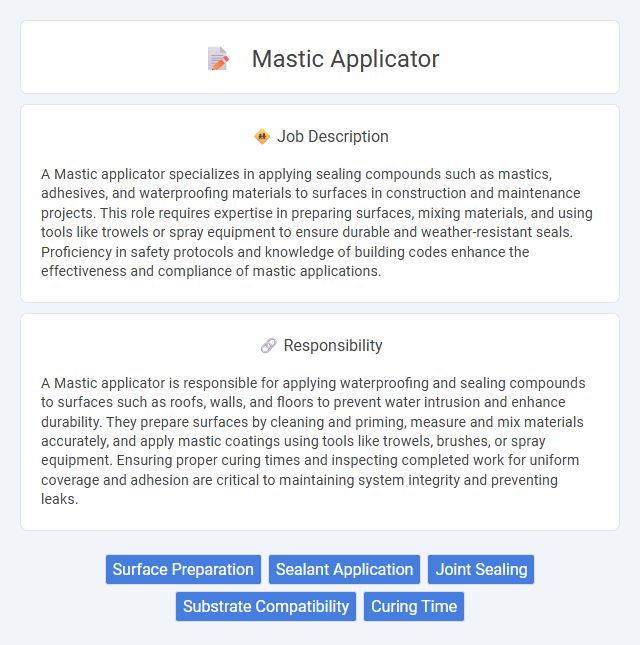
A Mastic applicator specializes in applying sealing compounds such as mastics, adhesives, and waterproofing materials to surfaces in construction and maintenance projects. This role requires expertise in preparing surfaces, mixing materials, and using tools like trowels or spray equipment to ensure durable and weather-resistant seals. Proficiency in safety protocols and knowledge of building codes enhance the effectiveness and compliance of mastic applications.
Candidates who are physically fit and able to handle repetitive manual tasks are likely suitable for a mastic applicator job, as it often requires standing for extended periods and applying adhesives with precision. Individuals with good hand-eye coordination and attention to detail may have a higher probability of success in this role. Those with limited mobility or difficulty performing fine motor skills might find the job challenging or less suitable.
Qualification
A Mastic Applicator must possess expertise in handling various types of mastics, including sealants and adhesives, with precision and efficiency. Essential qualifications include knowledge of surface preparation, proper application techniques, and safety standards to ensure durable and watertight seals. Experience with tools such as caulking guns and spray equipment, along with physical stamina and attention to detail, are critical for success in this role.
Responsibility
A Mastic applicator is responsible for applying waterproofing and sealing compounds to surfaces such as roofs, walls, and floors to prevent water intrusion and enhance durability. They prepare surfaces by cleaning and priming, measure and mix materials accurately, and apply mastic coatings using tools like trowels, brushes, or spray equipment. Ensuring proper curing times and inspecting completed work for uniform coverage and adhesion are critical to maintaining system integrity and preventing leaks.
Benefit
A mastic applicator likely enhances building durability by creating effective waterproof and airtight seals, which can reduce energy costs and prevent structural damage. Efficient application of mastic may improve insulation performance, contributing to a more comfortable indoor environment. The proficiency of a mastic applicator could also increase project longevity and reduce maintenance expenses over time.
Challenge
Working as a mastic applicator likely involves navigating significant challenges related to precision and environmental conditions. The probability of encountering difficulties increases when applying mastic in tight spaces or uneven surfaces, requiring steady hands and keen attention to detail. Weather factors such as temperature and humidity may further complicate adhesion quality, demanding adaptive techniques and problem-solving skills.
Career Advancement
A career as a mastic applicator offers opportunities for advancement through specialization in industrial coatings and sealants, which increases job marketability and earning potential. Gaining certifications in safety protocols and advanced application techniques can lead to supervisory or project management roles within construction and maintenance companies. Continuous skill development and hands-on experience accelerate progression toward senior positions, including quality control and inspection.
Key Terms
Surface Preparation
Surface preparation is crucial for a mastic applicator, ensuring all substrates are clean, dry, and free from dust, grease, and loose particles to promote optimal adhesion. This process often involves scraping, sanding, and priming surfaces according to manufacturer's specifications and project requirements. Properly prepared surfaces enhance the durability and effectiveness of mastic sealants in construction and waterproofing applications.
Sealant Application
A Mastic applicator specializes in the precise application of sealants to ensure airtight and watertight barriers in construction projects. Expertise in sealant types, including polyurethane and silicone, is essential for effective adhesion and durability. Proficiency in surface preparation and use of specialized tools guarantees optimal sealant performance and longevity.
Joint Sealing
Mastic applicators specialize in the precise application of sealants to joints, ensuring waterproof and airtight seals in construction and industrial projects. Their expertise in handling various mastic compounds is critical for preventing leaks and protecting structural integrity. Effective joint sealing enhances durability and energy efficiency in buildings, reducing maintenance costs over time.
Substrate Compatibility
Mastic applicators must ensure precise substrate compatibility to enhance adhesion and durability of sealants on various surfaces such as concrete, metal, wood, and masonry. Proper surface preparation and material selection are critical for preventing bond failure and ensuring long-lasting mastic performance under environmental stressors. Expertise in assessing substrate porosity, cleanliness, and moisture content directly influences the effectiveness of the application process.
Curing Time
Mastic applicators must understand the curing time of sealants to ensure proper adhesion and durability. Curing time varies based on temperature, humidity, and type of mastic, typically ranging from 24 to 72 hours. Proper curing prevents premature failure and enhances the longevity of the applied sealant in construction and maintenance projects.
 kuljobs.com
kuljobs.com